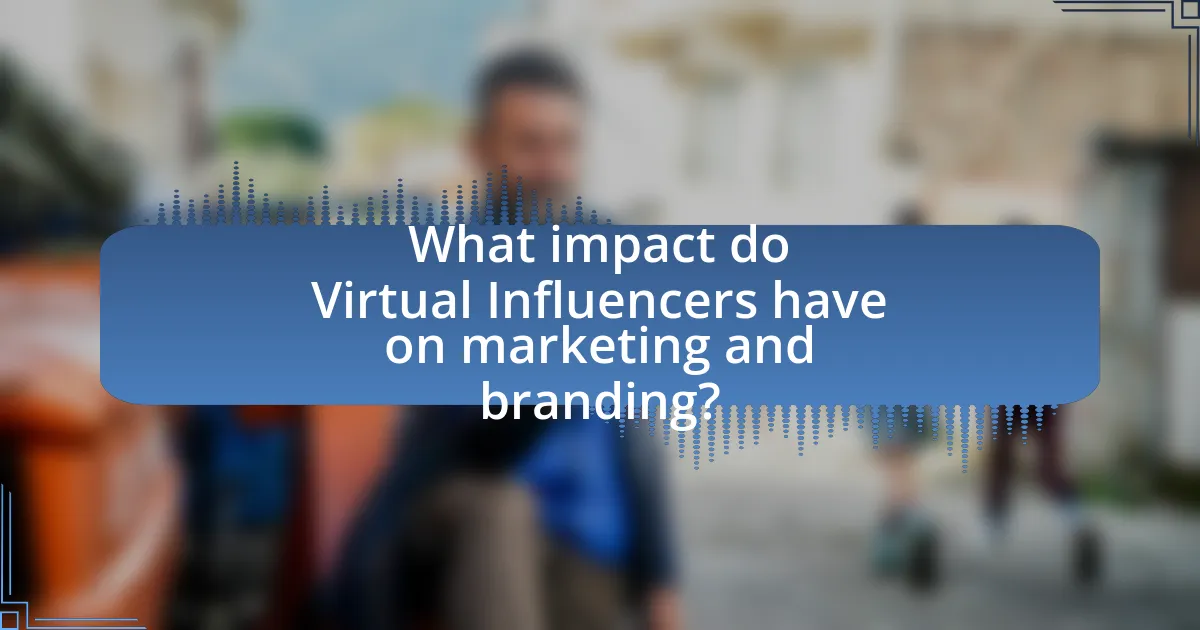Virtual influencers and AI avatars are digital characters created using CGI and AI technologies, designed to engage audiences on social media and marketing platforms. This article explores the differences between virtual influencers and traditional celebrities, highlighting their unique characteristics, creation processes, and the advantages they offer in marketing. It examines the growing popularity of virtual influencers, their impact on consumer behavior, and the ethical considerations surrounding their use. Additionally, the article discusses future trends, technological advancements, and best practices for brands collaborating with these digital personas, emphasizing the importance of authenticity and audience engagement in this evolving landscape.
![]()
What are Virtual Influencers and AI Avatars?
Virtual influencers and AI avatars are digital characters created using computer-generated imagery (CGI) and artificial intelligence (AI) technologies, designed to engage with audiences on social media and other platforms. These entities can be programmed to exhibit human-like behaviors, personalities, and aesthetics, allowing them to interact with followers, promote products, and participate in marketing campaigns. The rise of virtual influencers is evidenced by their increasing popularity, with examples like Lil Miquela, who has millions of followers and collaborates with major brands, demonstrating their effectiveness in digital marketing.
How do Virtual Influencers differ from traditional celebrities?
Virtual influencers differ from traditional celebrities primarily in their digital nature and creation process. Unlike traditional celebrities, who are real individuals with personal experiences and public personas, virtual influencers are computer-generated characters designed to engage audiences through social media and marketing campaigns. For instance, Lil Miquela, a well-known virtual influencer, is entirely fictional yet has amassed millions of followers, showcasing how these digital personas can effectively influence consumer behavior without the complexities of human celebrity life, such as scandals or personal issues. This distinction highlights the unique marketing potential of virtual influencers, as they can be programmed to align perfectly with brand values and target demographics, offering a level of control that traditional celebrities cannot provide.
What characteristics define a Virtual Influencer?
Virtual influencers are digital characters created using computer-generated imagery (CGI) that possess distinct characteristics such as a defined personality, a unique aesthetic, and the ability to engage with audiences through social media platforms. These influencers often have backstories and traits that resonate with specific demographics, allowing them to build a loyal following. For instance, Lil Miquela, a well-known virtual influencer, combines fashion, music, and social activism, which enhances her relatability and appeal. Additionally, virtual influencers can be programmed to maintain a consistent brand image and message, making them highly controllable marketing tools for brands.
How are AI Avatars created and maintained?
AI avatars are created using advanced algorithms, machine learning techniques, and 3D modeling software. These technologies enable the generation of realistic digital representations that can mimic human behavior and appearance. Maintenance involves continuous updates to the underlying models, incorporating new data to enhance realism and responsiveness, as well as regular content updates to keep the avatars relevant and engaging. For instance, companies like Synthesia and Reallusion utilize AI-driven tools to refine avatar interactions and visual fidelity, ensuring they remain appealing to audiences.
Why are Virtual Influencers gaining popularity?
Virtual influencers are gaining popularity due to their ability to engage audiences with relatable content while being entirely controlled by brands and creators. This control allows for consistent messaging and the ability to avoid controversies that often surround human influencers. Additionally, the rise of social media platforms has facilitated their visibility, with virtual influencers like Lil Miquela amassing millions of followers and collaborations with major brands, demonstrating their marketability. The global influencer marketing industry is projected to reach $16.4 billion by 2022, indicating a significant shift towards digital personas in marketing strategies.
What role does social media play in their rise?
Social media is crucial in the rise of virtual influencers and AI avatars, as it provides a platform for their visibility and engagement with audiences. These digital entities leverage social media to create and share content, interact with followers, and build a brand presence, which traditional celebrities also utilize. According to a report by Business Insider, 70% of Gen Z consumers are influenced by social media when making purchasing decisions, highlighting the effectiveness of these platforms in shaping consumer behavior and promoting virtual influencers. This demonstrates that social media not only facilitates their emergence but also amplifies their impact in the digital marketing landscape.
How do audiences perceive Virtual Influencers compared to real celebrities?
Audiences generally perceive Virtual Influencers as more relatable and accessible compared to real celebrities. Research indicates that Virtual Influencers, being digitally created, can be tailored to fit specific audience preferences, leading to a perception of authenticity and engagement that resonates with younger demographics. For instance, a study by the University of Southern California found that 60% of respondents felt more connected to Virtual Influencers due to their consistent online presence and ability to interact in real-time. In contrast, real celebrities often face scrutiny regarding their authenticity and personal lives, which can create a barrier between them and their audience. This difference in perception highlights the evolving landscape of celebrity culture, where Virtual Influencers are increasingly seen as viable alternatives to traditional celebrities.

What impact do Virtual Influencers have on marketing and branding?
Virtual influencers significantly impact marketing and branding by enhancing engagement and targeting specific demographics effectively. These digital personas can be tailored to resonate with particular audiences, allowing brands to create personalized marketing strategies. For instance, a study by Influencer Marketing Hub in 2021 revealed that campaigns featuring virtual influencers achieved engagement rates up to 50% higher than those with traditional influencers. This increased engagement translates into improved brand awareness and loyalty, as consumers often perceive virtual influencers as more relatable and authentic due to their curated narratives and consistent online presence.
How are brands leveraging Virtual Influencers for campaigns?
Brands are leveraging virtual influencers for campaigns by creating unique digital personas that engage audiences through social media platforms. These virtual influencers, such as Lil Miquela and Shudu, are designed to resonate with target demographics, allowing brands to craft tailored marketing messages that align with consumer interests. For instance, a study by Influencer Marketing Hub in 2021 revealed that campaigns featuring virtual influencers can achieve engagement rates of up to 10% higher than traditional influencers, demonstrating their effectiveness in capturing audience attention. Additionally, brands benefit from the ability to control the narrative and aesthetics of virtual influencers, ensuring consistent brand representation without the unpredictability associated with human influencers.
What are the advantages of using AI Avatars in advertising?
AI avatars in advertising offer several advantages, including enhanced personalization, cost-effectiveness, and 24/7 availability. These digital entities can be tailored to reflect specific brand identities and consumer preferences, leading to more engaging and relevant marketing experiences. Additionally, using AI avatars reduces costs associated with hiring human influencers, as they do not require fees, travel expenses, or accommodations. Furthermore, AI avatars can operate continuously without breaks, ensuring consistent brand messaging and interaction with consumers at any time. This combination of personalization, cost savings, and constant availability makes AI avatars a powerful tool in modern advertising strategies.
How do Virtual Influencers engage with their audience differently?
Virtual influencers engage with their audience differently by utilizing advanced technology to create personalized and interactive experiences. Unlike traditional influencers, virtual influencers can respond to audience interactions in real-time, adapting their content based on user feedback and preferences. This capability is enhanced by artificial intelligence, allowing them to analyze audience behavior and tailor their messaging accordingly. For instance, a study by the University of Southern California found that virtual influencers can maintain a consistent brand image while also evolving their persona based on audience engagement metrics, leading to higher levels of interaction and loyalty.
What ethical considerations arise with the use of Virtual Influencers?
The ethical considerations that arise with the use of Virtual Influencers include issues of authenticity, transparency, and potential manipulation of audiences. Virtual Influencers, being computer-generated entities, lack genuine human experiences, which raises questions about their ability to authentically connect with followers. Additionally, the lack of transparency regarding their artificial nature can mislead audiences into believing they are interacting with real individuals, potentially leading to deceptive marketing practices. Research indicates that 86% of consumers prefer transparency in influencer marketing, highlighting the importance of clear communication about the nature of Virtual Influencers. Furthermore, the potential for these digital personas to promote unrealistic standards of beauty or lifestyle can contribute to harmful societal norms, particularly among impressionable demographics.
How do issues of authenticity and transparency affect their credibility?
Issues of authenticity and transparency significantly impact the credibility of virtual influencers and AI avatars. When these digital entities present themselves as genuine and relatable, they foster trust among their audience; however, any perceived lack of authenticity or transparency can lead to skepticism and diminished credibility. For instance, a study by the Pew Research Center found that 86% of social media users believe that transparency about sponsorships and content creation is crucial for trust. This indicates that audiences are more likely to engage with virtual influencers who openly disclose their AI nature and the processes behind their content creation, reinforcing their credibility in a landscape where authenticity is paramount.
What are the potential risks of using AI Avatars in marketing?
The potential risks of using AI avatars in marketing include ethical concerns, misinformation, and consumer trust issues. Ethical concerns arise when AI avatars misrepresent reality, leading to deceptive marketing practices. Misinformation can occur if AI avatars promote false or misleading information, which can damage brand reputation and consumer relationships. Additionally, consumer trust issues may arise if audiences feel manipulated by AI-generated content, potentially leading to backlash against brands. A study by the Pew Research Center highlights that 64% of Americans believe that AI could lead to more misinformation, underscoring the importance of transparency in marketing practices involving AI avatars.
![]()
What does the future hold for Virtual Influencers and AI Avatars?
The future of Virtual Influencers and AI Avatars is poised for significant growth and integration into mainstream media and marketing. As technology advances, these digital entities will become increasingly sophisticated, utilizing machine learning and natural language processing to engage audiences more effectively. According to a report by Business Insider, the virtual influencer market is expected to reach $1.5 billion by 2025, driven by brands seeking innovative ways to connect with consumers. This growth indicates a shift in marketing strategies, where companies will leverage AI avatars for personalized interactions and targeted advertising, enhancing user experience and brand loyalty.
How might technology evolve to enhance Virtual Influencers?
Technology will evolve to enhance Virtual Influencers through advancements in artificial intelligence, augmented reality, and machine learning. These technologies will enable Virtual Influencers to exhibit more realistic human-like behaviors, emotions, and interactions, making them more relatable and engaging to audiences. For instance, AI algorithms can analyze audience preferences and tailor content in real-time, while augmented reality can create immersive experiences that allow users to interact with Virtual Influencers in their own environments. Additionally, machine learning can improve the personalization of interactions, leading to a deeper connection between Virtual Influencers and their followers.
What advancements in AI could change the landscape of celebrity culture?
Advancements in AI, particularly in generative models and deep learning, could significantly alter celebrity culture by enabling the creation of hyper-realistic virtual influencers and AI avatars. These technologies allow for the development of digital personas that can engage audiences through social media, advertisements, and entertainment without the limitations of physical presence or personal privacy. For instance, AI-generated characters like Lil Miquela have already gained substantial followings, demonstrating that virtual influencers can attract brand partnerships and fan engagement comparable to traditional celebrities. This shift could lead to a redefinition of fame, where digital personas become mainstream figures, influencing trends and consumer behavior in ways that traditional celebrities have historically dominated.
How will audience expectations shape the future of Virtual Influencers?
Audience expectations will significantly shape the future of Virtual Influencers by driving the demand for authenticity, relatability, and engagement. As audiences increasingly seek genuine connections, Virtual Influencers will need to adopt more human-like traits and behaviors to meet these expectations. For instance, a study by the University of Southern California found that 70% of consumers prefer brands that engage with them in a relatable manner, indicating that Virtual Influencers must evolve to foster deeper emotional connections. This shift will likely lead to the development of more sophisticated AI technologies that can analyze audience feedback and adapt content accordingly, ensuring that Virtual Influencers remain relevant and appealing to their target demographics.
What trends should we watch for in the Virtual Influencer space?
Key trends to watch in the Virtual Influencer space include increased personalization, enhanced interactivity, and the integration of AI-driven analytics. Personalization is becoming crucial as brands seek to create tailored experiences for audiences, with virtual influencers adapting their content to individual preferences. Enhanced interactivity is evident as platforms enable real-time engagement, allowing followers to influence content direction and decisions made by virtual influencers. The integration of AI-driven analytics is transforming how brands measure the effectiveness of virtual influencers, providing data on audience engagement and sentiment. These trends are supported by the growing investment in virtual influencer technology, with the market projected to reach $1.5 billion by 2024, indicating a robust future for this sector.
How might the integration of augmented reality influence Virtual Influencers?
The integration of augmented reality (AR) will significantly enhance the engagement and interactivity of virtual influencers. By utilizing AR, virtual influencers can create immersive experiences that allow users to interact with them in real-time, blurring the lines between digital and physical environments. For instance, AR can enable users to visualize virtual influencers in their own space, fostering a more personal connection and increasing brand loyalty. Research indicates that AR experiences can boost user engagement by up to 70%, demonstrating its potential to transform how audiences perceive and interact with virtual influencers.
What new platforms could emerge for AI Avatars in the coming years?
New platforms for AI avatars could include decentralized social networks, virtual reality environments, and augmented reality applications. Decentralized social networks, such as those built on blockchain technology, can provide users with more control over their digital identities and avatars, fostering a community-driven approach. Virtual reality environments, like the metaverse, are expected to expand, allowing users to interact with AI avatars in immersive settings. Augmented reality applications could also rise, enabling AI avatars to interact with users in real-world contexts through smartphones and AR glasses. These emerging platforms will likely enhance user engagement and redefine digital interactions, as evidenced by the growing investment in metaverse technologies and the increasing popularity of AR applications in social media.
What best practices should brands follow when working with Virtual Influencers?
Brands should prioritize authenticity and transparency when working with virtual influencers. Authenticity ensures that the virtual influencer aligns with the brand’s values and resonates with the target audience, while transparency builds trust by clearly communicating the nature of the virtual influencer’s existence. For instance, a study by Influencer Marketing Hub indicates that 63% of consumers prefer brands that are honest about their marketing practices. Additionally, brands should engage in consistent and creative storytelling that leverages the unique capabilities of virtual influencers, such as their ability to create immersive experiences. This approach not only enhances brand engagement but also fosters a deeper connection with consumers, as evidenced by the growing popularity of campaigns featuring virtual influencers like Lil Miquela, who has successfully generated significant social media engagement and brand partnerships.
How can brands ensure authenticity in their collaborations with AI Avatars?
Brands can ensure authenticity in their collaborations with AI Avatars by aligning the avatar’s persona with the brand’s values and messaging. This alignment fosters a genuine connection with the target audience, as consumers are more likely to engage with avatars that reflect the brand’s identity. For instance, a study by the University of Southern California found that consumers perceive virtual influencers as more relatable when their characteristics resonate with the brand’s ethos. Additionally, brands should involve their audience in the creation process, allowing for feedback and interaction, which enhances the perceived authenticity of the AI Avatar.
What strategies can enhance audience engagement with Virtual Influencers?
To enhance audience engagement with Virtual Influencers, brands should implement interactive content strategies, such as live Q&A sessions and polls. These strategies foster real-time interaction, allowing audiences to feel more connected and involved. For instance, a study by the Digital Marketing Institute found that interactive content generates twice the engagement compared to static content. Additionally, leveraging user-generated content can create a sense of community, as audiences share their experiences and opinions related to the Virtual Influencer, further increasing engagement levels.

